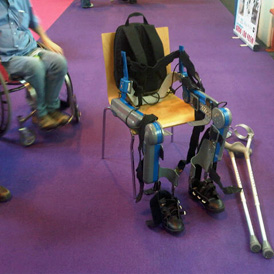‘Robotic trousers’ hailed as breakthrough for paralysis
A “bionic” walking device has been launched in the UK, giving new hope to those confined to wheelchairs. Tom Clarke finds out how they work.
The ReWalk can help paraplegics to stand and walk – using crutches for stability – when they lean forward and move their upper body in different ways.
It uses a sophisticated computer system along with motion sensors to help paraplegics stand, walk and even climb stairs.
Israeli engineer Amit Goffer set about designing the ‘robotic trousers’ after he was left partially paralysed in an accident in 1997.
One version of the device, for supervised use in hospitals and rehabilitation centres, is already available for almost £77,000.
The other – to be used without supervision by those who have had training – is still undergoing trials in Israel, America and Europe. It is hoped to be available by the end of 2011.
Channel 4 News Science Correspondent Tom Clarke was at the launch and spoke to Radi Kaoif, the first person to try the device.
Radi Kaoif was paralysed from the waist down fighting in the Lebanon with the Israeli army. Since 1988 he’s used a wheelchair to get around – but two years ago he was the first man to use use Re-walk.
“Using ReWalk I see people eye to eye. I feel normal, I stand and I feel tall. It’s fantastic for me.”
Using ReWalk I see people eye to eye. I feel normal, I stand and I feel tall. It’s fantastic for me. Radi Kaoif
A remote control on Radi’s wrist switches the device it from standing to walking mode. A tilt sensor controls each step. Motors in the legs do the work his muscles once did. In the back pack a battery lasting 8 hours.
Another setting allows the user to climb stairs.
The device was getting its UK debut today at the Naidex exhibition – the UK’s largest rehabilitation and assisted living show.
It’s makers are trying to market this to spinal injury clinics. But at the end of the year they are launching a domestic version.
According to John Borthwick, Chairman of the Spinal Injuries Association, the technology has its limitations.
It’s not suitable for people paralysed from the neck down. However, for paraplegics who can use the device there are definite health benefits from standing and walking.

“Looking at it at the moment people would need to be very fit – with pretty good upper arm strength.
“Standing, moving the body in the normal way is going to help the cardiovascular system and the lymphatic system and improve the way people feel.”
Cost is an issue too. The current model, for use in rehabilitation clinics is around £77,000. A domestic version launched later this year will cost around £44,000.
That could be affordable, said Borthwick for those who have received compensation for a spinal injury, but not for the majority.
“For a person who’s on benefits, as many of our spinal injury members are, no there isn’t anyway they could afford that,” he said.
For a person who’s on benefits, as many of our spinal injury members are, no there isn’t anyway they could afford that. John Borthwick, Chairman of the Spinal Injuries Association
But there could be benefits if regional spinal injury centres had the devices for people to use on a regular basis to get out of their wheelchairs and stretch their legs.
“I’ve been injured 44 years now and there’s been lots of breakthroughs announced but they’ve never really amounted to much. This will help people in their movements but it’s not going to cure people.
“Most people are still going to be using a wheelchair and for getting around – on the street a wheelchair is still going to be quicker.”